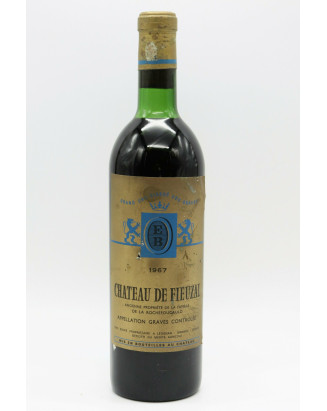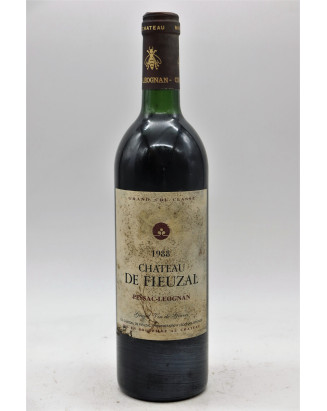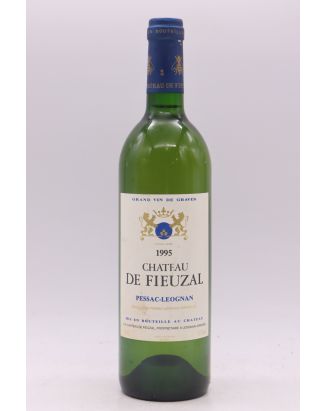









The history of Château de Fieuzal dates back more than 400 years, to a time when this vast wine estate was managed by modest winegrowers. The estate acquired its current name in 1864, in honour of Lovely Fieuzal, the last descendant of the Fieuzal family, who played a decisive role in the recognition of the vineyard.
One of the landmark events in Fieuzal's history is the 1893 vintage, which became legendary after being served at Pope Leo XIII's table in the Vatican. This moment of glory largely contributed to establishing the estate's international reputation. In 1959, Château de Fieuzal was elevated to the rank of Grand Cru Classé de Graves for its red wines, consolidating its prestige among the great names of Bordeaux.
The estate has gone through several periods of change, notably under the direction of five different families, each bringing their own vision and personal touch. After a difficult period in the 1990s, the estate was bought in 2001 by Lochlann Quinn, an Irish businessman, who invested massively to modernise and revitalise Fieuzal. The arrival of Stephen Carrier as director and winemaker in 2007, as well as the collaboration with consultant Thomas Duclos, marked a new era of excellence for the estate.
Château de Fieuzal extends over a vineyard of 70 hectares, of which 60 hectares are dedicated to red grape varieties and 10 hectares to white grape varieties. The exceptional geographical location of the estate on gravelly ridges, typical of the Graves appellation, plays a crucial role in the quality of the wines produced here. The soil, consisting of gravel, sand and clay, is particularly well-drained and allows the vines to draw rich minerals, while maintaining vital freshness, even during periods of drought.
The terroir of Château de Fieuzal is also marked by the presence of the Eau Blanche stream, which brings natural and beneficial humidity, especially during drier vintages. The best plots, located on sloping hills, reach up to 58 metres in altitude, offering an ideal environment for growing Bordeaux's emblematic grape varieties.
The estate's grape varieties are typical of the region, with a majority of Cabernet Sauvignon (50%), complemented by Merlot (37%), Petit Verdot (8%) and Cabernet Franc (5%) for the reds. As for the white wines, the vineyard consists of a perfect balance between Sauvignon Blanc (50%) and Sémillon (50%). The vines of Château de Fieuzal are on average 35 years old, with some plots containing century-old vines, notably the Petit Verdot plants, planted in 1908.
Vinification at Château de Fieuzal reflects a harmonious marriage between tradition and modernity. In 2012, the estate undertook a major renovation, completely modernising its winemaking facilities to allow for greater precision in the elaboration of its wines.
Red wine vinification
The red wines of Château de Fieuzal are vinified in a combination of wooden and stainless steel vats. This method allows for the preservation of the integrity and expression of each grape variety. Cabernet Sauvignon and Petit Verdot are vinified in stainless steel vats, while Merlot and Cabernet Franc are reserved for wooden vats. The use of these different vats, of varying sizes ranging from 15 to 185 hectolitres, allows for meticulous plot-by-plot vinification, ensuring a rigorous selection of the best berries.
The ageing of red wines is done in French oak barrels, with a percentage of 35% to 50% new barrels, depending on the characteristics of the vintage. The duration of ageing varies from 16 to 24 months, giving the wines the structure and elegance necessary to age harmoniously.
White wine vinification
The white wines of Château de Fieuzal also benefit from particular attention. Vinification takes place in French oak barrels, with 50% new barrels. Unlike the reds, there is no malolactic fermentation for the whites, which allows them to retain their freshness and tension. Ageing lasts between 16 and 18 months, depending on the style of the vintage, giving the wines a full texture and remarkable aromatic balance.
Château de Fieuzal produces cuvées in both red and white, each reflecting the diversity of its terroir and the expertise of its team.
Château de Fieuzal Rouge - Grand Cru Classé de Graves
This cuvée is the result of a blend dominated by Merlot (65%), complemented by Cabernet Sauvignon (30%) and a touch of Petit Verdot (5%). It is distinguished by its aromatic richness, with notes of black fruits, spices and a beautiful tannic structure. Its silky texture and ageing capacity make it an ideal wine to drink after several years in the cellar.
Château de Fieuzal Blanc
This white wine, made from equal parts of Sauvignon Blanc and Sémillon, is a true model of balance. Aged for 12 months in French oak barrels, it is distinguished by its aromas of zesty fruits, white flowers and its unctuous texture. The minerality brought by the gravelly terroir gives the wine great freshness and a persistent finish. It is a wine for keeping, perfect for lovers of highly refined whites.
L'Abeille de Fieuzal Rouge
The estate's second wine, L'Abeille de Fieuzal rouge is more accessible in its youth. It offers a fine balance between fruitiness and structure, with a more immediate approach than its elder, while maintaining a beautiful freshness.
L'Abeille de Fieuzal Blanc
As with the reds, this cuvée is a second wine that is more accessible in its youth. L'Abeille de Fieuzal blanc is a beautiful introduction to the world of Fieuzal's great whites, with its fruity aromas, freshness and natural elegance.
The vintages of Graves and Pessac-Léognan, two Bordeaux appellations, stand out for their consistent quality. The years 1975, 1982, 1983, 1985, 1986, 1988, 1989 and 1990 are particularly prized for their finesse and balance. The vintages 1998, 2000, 2005, 2008, 2009 and 2010 are equally remarkable for their structure and ageing potential. More recently, the vintages 2012, 2014, 2015, 2016, 2017, 2018, 2019 and 2020 confirm this continuing excellence, with wines offering both elegance and longevity.
Explore all the Grands Crus Classés de Graves, an appellation renowned for the diversity and quality of its wines. At the top of the list, the First Growth of 1855, Château Haut-Brion of Pessac-Léognan, is a historical reference. For red andwhite wines, estates such as Château Bouscaut, Château Carbonnieux, Château Malartic-Lagravière, Château Olivier, Château Latour-Martillac and Domaine de Chevalier offer interesting cuvées. For reds, you can discover the wines of Château Fieuzal, Château Haut-Bailly, Château Latour Haut-Brion, Château La Mission Haut-Brion, Château Pape-Clément and Château Smith-Haut-Lafitte. White wine enthusiasts can turn to the productions of Château Couhins, Château Couhins Lurton and Château Laville Haut-Brion. These estates offer you a wide range of wines to discover in the heart of the Graves region.
Château de Fieuzal embodies the excellence of the Grands Crus of Bordeaux, thanks to its exceptional terroir, rich history and commitment to quality. Whether for red or white wines, each bottle offers a unique experience, combining elegance, complexity and ageing potential. Whether you are a wine lover looking for a cuvée to enjoy today or a wine to keep precious for a special occasion, the wines of Château de Fieuzal will meet your expectations.